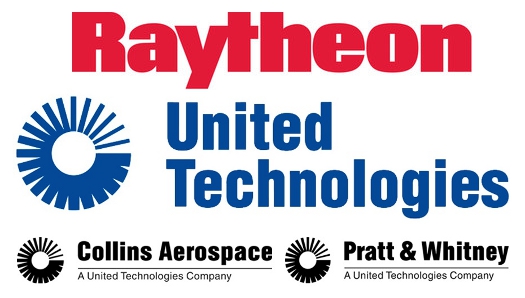 |
| June 11, 2019 | Volume 15 Issue 22 |
Designfax weekly eMagazine
Archives
Partners
Manufacturing Center
Product Spotlight
Modern Applications News
Metalworking Ideas For
Today's Job Shops
Tooling and Production
Strategies for large
metalworking plants
Raytheon and United Technologies to merge to make aerospace and military juggernaut
Raytheon and United Technologies have entered into an agreement to combine.
The two companies are calling the move "an all-stock merger of equals." But the merger will also create an aerospace juggernaut that makes the new company, to be called Raytheon Technologies Corporation, a formidable force in the aero and military sectors.
With U.S. military budgets increasing, the timing is good on that front, too.

A June 9 NBC News article stated, "The deal was described as the largest ever in the defense and aerospace industry, far eclipsing United Technologies' purchase of Rockwell Collins, a major maker of avionics and aircraft parts, for $30 billion in 2017."
United Technologies, comprised of Collins Aerospace and Pratt & Whitney, will offer a complementary portfolio of platform-agnostic aerospace and defense technologies. The combination excludes Otis and Carrier, which are expected to be separated from United Technologies in the first half of 2020.
Raytheon, a technology and innovation leader specializing in defense, civil government, and cybersecurity solutions, is known for its integrated, space and airborne, and missile defense systems.
According to a June 10 AP news story, "The combined company, which will count among its portfolio of weaponry the F-35 fighter jet engines, Patriot and Tomahawk missile systems in addition to space suits and intelligence technology as well as Pratt & Whitney engines used in both commercial and military aircraft, anticipates annual revenue of $74 billion if approved."
"Analysts said the deal makes sense because the two companies' core businesses don't overlap greatly, meaning they're not likely to run into regulatory roadblocks," according to NBC News.
A press release issued by Raytheon and United Technologies jointly said, "The combined company will have approximately $74 billion in pro forma 2019 sales. With a strong balance sheet and robust cash generation, Raytheon Technologies will enjoy enhanced resources and financial flexibility to support significant R&D and capital investment through business cycles."
"That means it still trails Boeing Co. in heft, but the deal may give the soon-to-be-renamed Raytheon Technologies Corp. leverage with suppliers and contractors over other heavyweights in the industry like Lockheed Martin Corp. and Northrop Grumman Corp," said the AP story.
Under the terms of the agreement, which was unanimously approved by the Boards of Directors of both companies, Raytheon shareowners will receive 2.3348 shares in the combined company for each Raytheon share. Upon completion of the merger, United Technologies shareowners will own approximately 57 percent and Raytheon shareowners will own approximately 43 percent of the combined company on a fully diluted basis. The merger is expected to close in the first half of 2020, following completion by United Technologies of the previously announced separation of its Otis and Carrier businesses. The timing of the separation of Otis and Carrier is not expected to be affected by the proposed merger and remains on track for completion in the first half of 2020. The merger is intended to qualify as a tax-free reorganization for U.S. federal income tax purposes.
Key benefits and strengths of the merger were listed by the companies as:
- Balanced and diversified aerospace and defense portfolio that is resilient across business cycles: The merger establishes a broad and complementary portfolio of platform-agnostic capabilities across the high-growth segments of aerospace and defense, reducing risk of concentration in any individual platform or program.
- Highly complementary technology and R&D platform: With a combined annual company and customer funded R&D spend of approximately $8 billion, seven technology Centers of Excellence, and over 60,000 engineers, the company will develop new, critical technologies faster and more efficiently than ever before. Areas of joint advancement include, but are not limited to: hypersonics and future missile systems; directed energy weapons; intelligence, surveillance, and reconnaissance (ISR) in contested environments; cyber protection for connected aircraft; next-generation connected airspace; and advanced analytics and artificial intelligence for commercial aviation.
- Attractive financial profile with strong cash-flow generation and balance sheet: Robust free cash-flow growth and a strong balance sheet will support continued investment and return of capital to shareowners. The combined company expects to return $18 billion to $20 billion of capital to shareowners in the first 36 months following completion of the merger. As a result of the combination, the company also expects to capture more than $1 billion in gross annual run-rate cost synergies by year four post-close, with approximately $500 million in annual savings returned to customers. In addition, the combination presents significant long-term revenue opportunities from technology synergies.
Raytheon said it plans to consolidate its four businesses into two businesses to be named Intelligence, Space & Airborne Systems and Integrated Defense & Missile Systems. The new businesses will join Collins Aerospace and Pratt & Whitney to form the four businesses of Raytheon Technologies.
The combined company's Board of Directors will be comprised of 15 members, consisting of eight directors from United Technologies and seven from Raytheon, with the lead director from Raytheon. Tom Kennedy will be appointed Executive Chairman and Greg Hayes will be named CEO of Raytheon Technologies. Two years following the close of the transaction, Hayes will assume the role of Chairman and CEO.
Raytheon Technologies will be headquartered in the greater Boston metro area, and will retain a corporate presence in existing locations.
Sources: Raytheon, United Technologies, AP, NBC News
Published June 2019
Rate this article
View our terms of use and privacy policy
